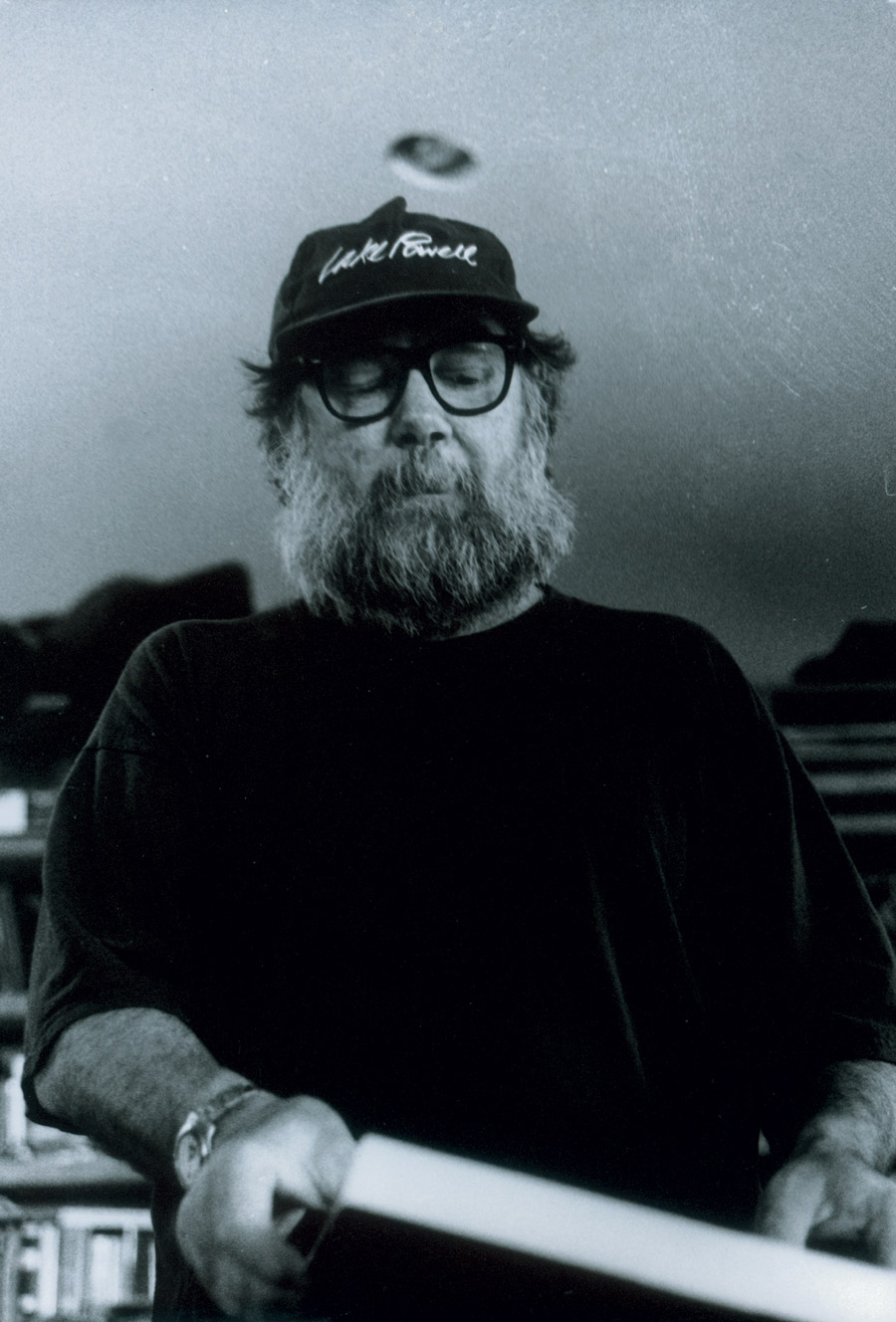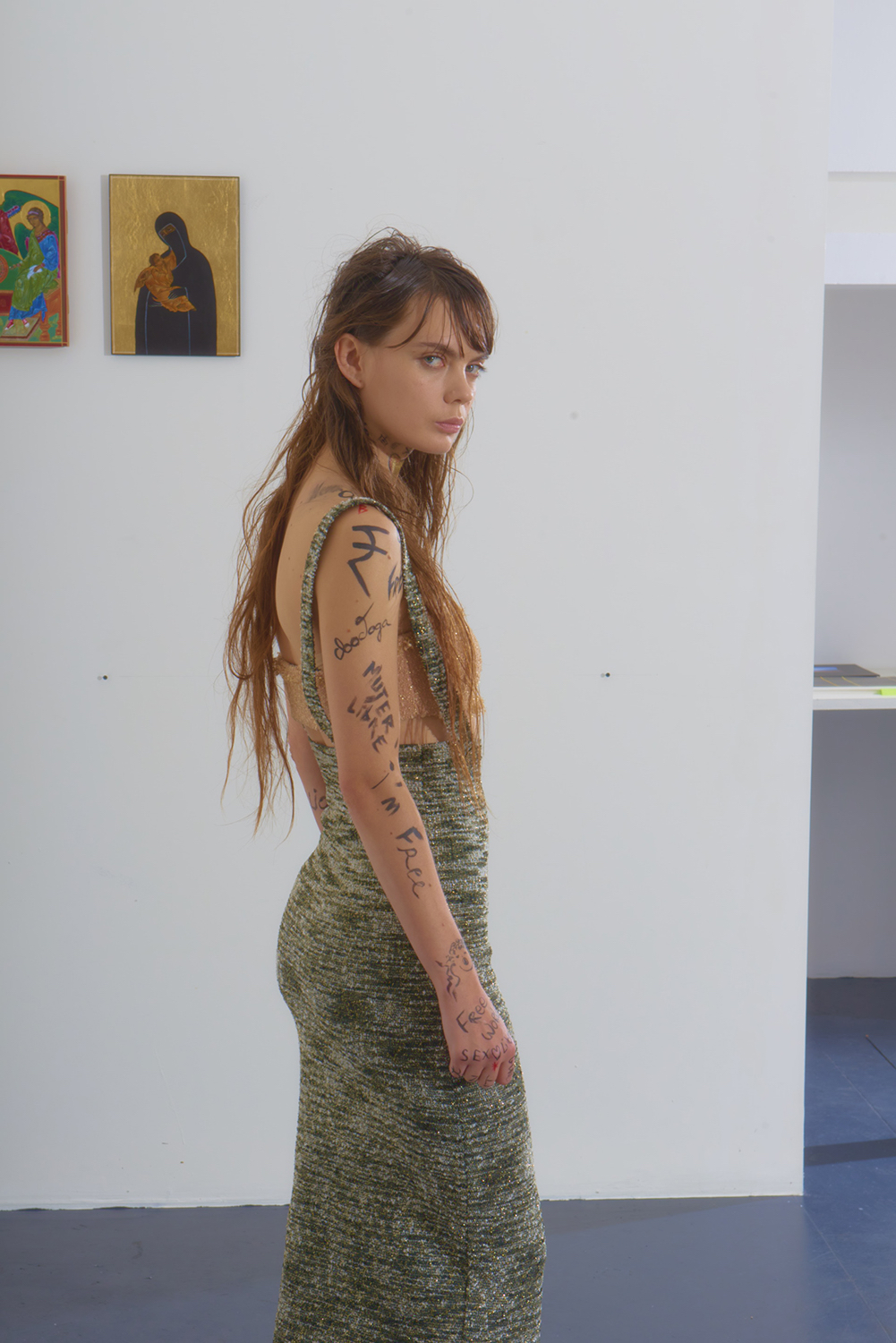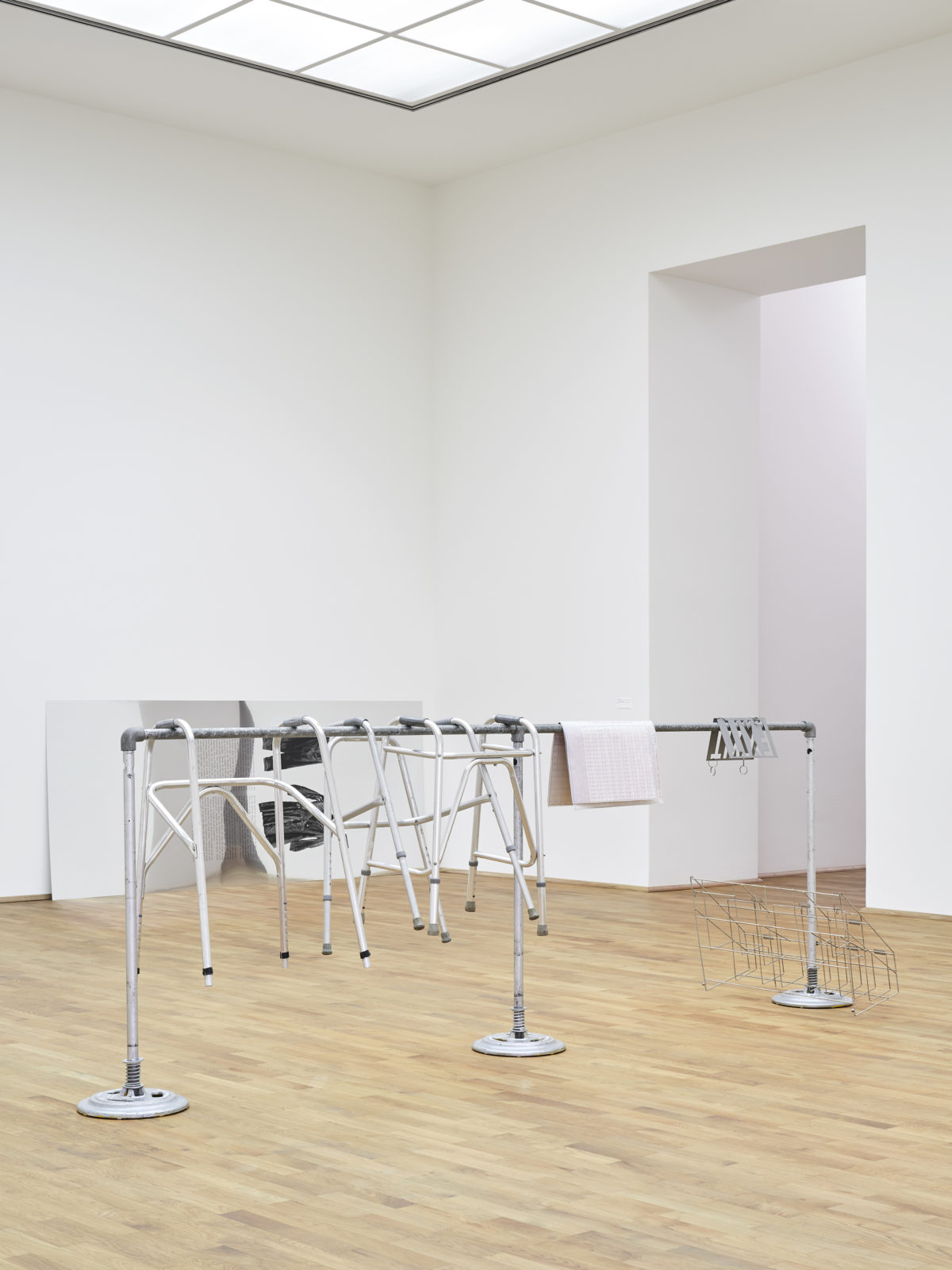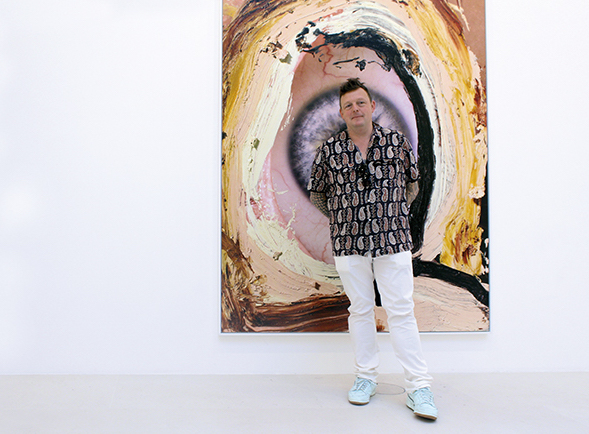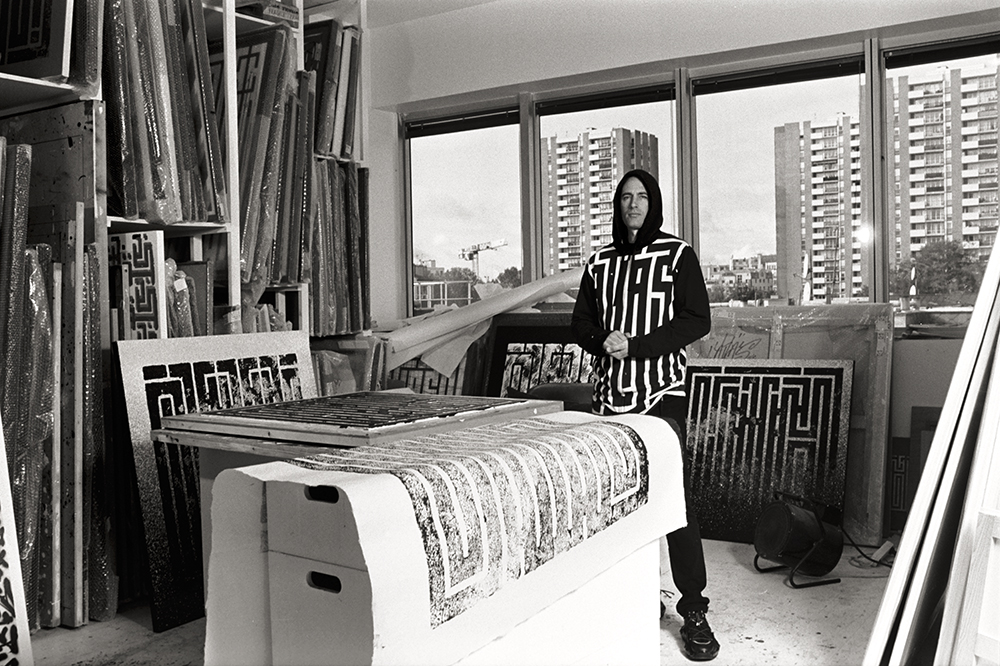
Agnès B - L’Atlas Sweatshirt / Jimmy Choo - Leather and stretch mesh «Diamonds Trail» sneakers / L’atlas' own pants
A MEETING BETWEEN L’ATLAS & ARMELLE LETURCQ
By Armelle Leturcq
Coming up in the graffiti scene of the 1990s, L’Atlas belongs to a generation of graffiti artists known as the New School, which followed in the wake of renowned taggers JonOne, Psyckoze and Bando. A globetrotter since his teen years, L’Atlas, alias Jules Dedet, travels the world in search of the ancestral calligraphy techniques he incorporates into his creative universe. Optical art, minimalist typography and archaeology form the backbone of his stunning black-and-white murals. With the ambition of creating a new graphic language, he quickly took his street art to galleries in Paris and around the world. Today, he brings the same agility and style to Jimmy Choo’s new men’s fragrance Urban Hero, a cocktail of fresh lemon caviar and black pepper notes…
Can you describe your background for me?
I became interested in graffiti in the early 1990s with the arrival of hip-hop culture in France: NTM, MC Solaar, IAM—they all released their first albums in 1991. Paris already had a vibrant graffiti scene for about ten years with people like JonOne, Bando and Psyckoze. I was twelve years old in 1990 so my generation is part of the new school. There had already been a wave of French graffiti artists who had gone to New York and returned in the 1980s. When I started doing graffiti in the 1990s, we were called the New School. At that time, while continuing to pursue my love for graffiti, I thought it was necessary to nourish this school with other influences—especially from calligraphy. Took an early interest in all the calligraphy movements. It took me almost ten years to create my own universe. I come from a film family. I had a Leica and I photographed everything that was going on in Paris. Then I started tagging, taking a break, being a DJ—well, like everyone else at the time! But I knew from the start that I was interested in visual art: the eye more than the ear. In 1996, I chose the name L’Atlas. With “Atlas”, no matter what language, country or people I interacted with, I knew the name would mean something. At least a geographical atlas, even if you don’t know anything about Greek mythology! I chose that name when I was in Brazil. I was eighteen years old and the friend I lived with was a geographer. He had loads of historical and geographical atlases and all that. It all started with that word and those books. After 1996, I started tagging around Paris, but not murals, graffiti or throw ups. I just focused on the pure gesture. It turned out that I had accidentally tagged Agnès b’s truck and her daughter tracked me down. She knew Space Invader who gave her my email. I was just eighteen years old when I met Agnès. She took some photos and used an entire black-and-white roll on just my tags in Paris. She threw me a line and asked me what I wanted to do with my life, if I wanted to be a model. But I wasn’t interested. She could tell I wanted to be an artist, but I was still just developing my visual and graphic style. I asked her to give me some time because I was still very young. After that I spent three years in Morocco, Cairo and Syria to meet some calligraphy masters. Then I went to China and Japan. I filmed everything because I wanted to remember and hold on to this ancestral practice.
When you say “ancestral practice”, are you referring to calligraphy?
Yes, the true old style of calligraphy. I filmed all these people and learned their techniques in order to reinterpret them in graffiti. But there was also this somewhat conceptual idea of taking all the Eastern codes of calligraphy and injecting them back into Latin typography to create an “Atlasic” type of writing, in the universal sense: a kind of writing between letter and shape, between alphabet and ideogram. When I was in Cairo, I spent six months working every day creating different shapes on paper.
Did you do it all on your own, without going to school?
Yes, all alone. I studied art history and archaeology in Toulouse for two years. In the last year of the Deug degree, I traveled to the Atlas Mountains in Morocco with a calligrapher to start learning classical calligraphy. But I quit school before it started to hold me back, because I was starting to feel like everything had been done in art history. Since I really wanted to be an artist, I had to ignore art history and try to start from scratch. Learning from calligraphers through face-to-face lessons really helped me to retain things and make it a personal experience. After that, for three or four years I worked in film because my father is Tann Dedet, who edited all the films by Truffaut, Pialat and Garrel. I worked in traditional analog editing, hence the scotch tape. Then I worked on film sets and produced making-of films. I dabbled in acting, too. So I flirted with that industry for four or five years. It allowed me to spend the rest of my time travelling and learning more about my true passion of calligraphy. Then I did my first paintings in 2001. In Greek mythology, Atlas has seven daughters – the constellation of the Pleiades – and they symbolize the universe in motion. I was inspired by mythology when developing this project. MY goal was to do paintings without selling them – and they’re still in my studio. I started taking black-and-white photos of my paintings in the street. I showed them to Agnès b and told her I wanted to do the same thing all over the world and travel with my paintings.
At first you were doing calligraphy in the street, right?
Yes, I did graffiti in the street, throughout the 1990s. For me, graffiti is calligraphy because it is about gesture – even if it is seen as vandalism. I liked their two energies: the meditative side of calligraphy where you work at home for hours and the impulsive, adrenaline-fueled side of graffiti. My first project aimed to combine painting and photography. These same seven paintings have travelled to forty cities. The project is called “Wandering Canvases” and it is still going on. I take all the pictures with a Rolleiflex on 6x6 black-and-white film. That project allowed me to make the leap from photography to painting.
Is it the photo or the canvas that is the artwork?
It’s both. I’m not selling that project. I publish a book every ten years to show the works, but I don’t sell the photos. I still exhibit them, though. At the Musée en Herbe, where I have an exhibition at the moment, there is a whole wall of them.
Did you start the series in 2001?
Yes, in September 2001. And at that time Agnès b’s held her first exhibition on street art. I showed a video and one of my paintings. It was Agnes who sent me to Tokyo, New York and Berlin with my paintings. At the same time, I was also exhibiting my work in her shops, which allowed me to travel for the first time when I was just twenty years old when and didn’t have a penny to my name.
Agnès has always promoted artists who do something different. She isn’t stuck in a contemporary art straitjacket.
Yes, and she also has the courage to invest in young artists.
Do you still consider yourself a street artist?
It means everything and nothing, but today I would just say that I paint. It’s true that I do outside works once or twice a year, but they are always commissions. I don’t really like labels. I just like to say that I do photography, calligraphy, staging and painting. What will remain afterwards? A canvas. Today I am a painter. I like optical art, minimal art and geometric abstraction. Those are the movements that influenced me the most. Everything I do is meant to break down barriers. I would like to change the way people look at the world. Op art collectors and young graphic designers can find something that speaks to them in my art. That pushes street art fans to take an interest in other movements and vice versa.
Do you work in series? Is each painting done in several copies?
Yes, they are series, but each painting is unique. There are series on mounted paper stamped with prints, and others that are more optical and close to kinetic art, where I use fluorescent paint to cause a retinal vibration. But all the series share a common link to writing.
Does each series have a name?
Yes, I’m already sorting my paintings into series. For example, there is a folder called “Lines and Letters”, and inside there is a series called “Breakage”. There is a series within each series. Often, the name of the series is the name of the show, which is also the process I use to put together the series. For my exhibition called “Breakage”, I cut all the letters so they would appear broken. I also do a lot of sewer lid prints. It’s somewhat in the same spirit as making an atlas because it’s a kind of index. I made hundreds of chrome sewer lid prints set against a black background. Each time I take the GPS coordinates of the center of the sewer lid and write them on the back of the canvas. The project is called “Ground Print System” as a play on GPS. There are sewer lids in every city, so it’s an endless project.
How exactly do you go about your work on this project?
I paint the sewer lid and roll out the canvas on top of it to get a kind of impression.
Do you do it outdoors?
Yes, I use the street as my studio. In a similar way to seals and stamps, I use the ground as my brush. Every time I bring back a new impression, it influences my work in the studio because I can always look at a structure from the urban environment.
Have you ever done any public works?
Yes, a few large murals. I recently painted a building that is thirty-eight meters long for Emmaus in the twentieth arrondissement. In Marseille, I did a one-kilometer wall along a highway. I don’t want to go out and do illegal work anymore. I used to do illegal work on the street because I knew it would get people talking.
Which artists do you feel close to today?
A very wide range of artists, from Sol LeWitt and Vasarely to other optical, minimal or very conceptual artists like Julio Le Parc. I also like artists like TANC and ZEVS, who truly belong to their own separate movement and who have a different vision of painting.
What about JR, for example?
Yes, of course. I used to work with JR in the beginning. We did all the first street together.
It is still a new thing for street artists to be included in large contemporary art galleries. There was Keith Haring, but then there was a gap until recently.
In Paris, a revival took place after all the tags in Paris were removed in 2001. That marked the true beginning of street art for us. Since they removed all the graffiti from the past thirty years, it was like having a huge blank canvas. Everyone had to do their work all over again. So that’s when we started making logos. Before 2001, it was unheard-of for the city administration to remove graffiti on such a regular basis. That’s when the Galerie du Jour held its big Street Art exhibition. Paris was empty and so artists decided to use the spirit of graffiti by turning it on its head. That’s what ZEVS did by observing the way major brands have used public space to place their logos into the collective unconscious. We did the same thing but in our own way.
And now brands are doing guerilla advertising.
Yes, now the tables have turned again with street communications, street marketing and all that. But it works both ways and that’s how it’s always been. Of course, brands are inspired by artists and vice versa. Graphic designers who work for brands are like artists, too… There is bound to be a back-and-forth. But when Apple liquidates its logo in paint drips like ZEVS did two years ago, it’s appropriation.
It is important to be recognized by museums and institutions, as well? In fact, Beaubourg has never held a street art exhibition…
Not in France, no. There have been some in Los Angeles, London and Berlin, but in France the institutions are a little reluctant.
However, there is still an important French scene.
Of course, but when it comes to street art, the predominant mode is figurative and reminiscent of pop art. But it’s not representative. There is a whole section of our movement that does abstraction or works on letters and signs, which is underrepresented. Based on Artcurial sales, today’s market is almost all figurative art because it is the easiest to sell. Today, with the arrival of mass street art, illustrators from outside the graffiti scene are doing facades and things like that. This part of the market is overrepresented, while the whole abstract, calligraphic part is underrepresented.
What about your collaboration with Jimmy Choo for their new men’s perfume Urban hero?
They approached me looking for a French street artist and graphic designer in his forties… It went smoothly because the person who made the film is from the graffiti world and so they know exactly how it works. When we shot the film in Berlin, everything just clicked.
How does it feel to be a muse?
I already did something similar with Perrier.
But you weren’t directed.
No, it was my work. I had made all the cans, so I was hidden behind the scenes in a way. It acted like a shield, whereas this time it’s me. It’s always rewarding… I think it’s important for the artist to reveal who they are. It is true that the person and the work merge at some point. I’m on my path in my way. I’m much better prepared today than I was ten years ago, when I was still inside my work. Now I’ve taken a little more distance. L’Atlas is no longer me; it’s the name of my project. Today I am Jules Dedet, the artist who created this work. That’s why I can pose next to my work like I just did today. But for ten years, I never showed my face.
Does that allow you to reach an audience that doesn’t necessarily know street art as well? Did you hesitate before making that choice?
I often say no to brands, but for Jimmy Choo I said yes right away. They presented the whole project to us as it is today, and I didn’t see anywhere it might go wrong. They really wanted to show what I was doing. In the film, I’m shown tagging a big wall. They didn’t distort me. I’m forty years old, so now is the time to do it. I feel more confident and mature in my work.
Tell me about the marble series is in your studio.
It’s a series I produced in Greece with a marble worker from Tinos. I visited the quarries there and fell in love with their marble. We bought some blocks and cut them. He carved them. At each exhibition, I sacrifice one by exploding it into a form of performance. Then I pick up the pieces and rebuild it, a bit like in archaeology, and then exhibit them again after they’ve been broken, based on this idea of creating anachronistic pieces that make you wonder when it was made, like a bas-relief. It fits in well with atlases, Greece and archaeology.
Walk the line with L’Atlas, through March 22nd at the Musée en Herbe.
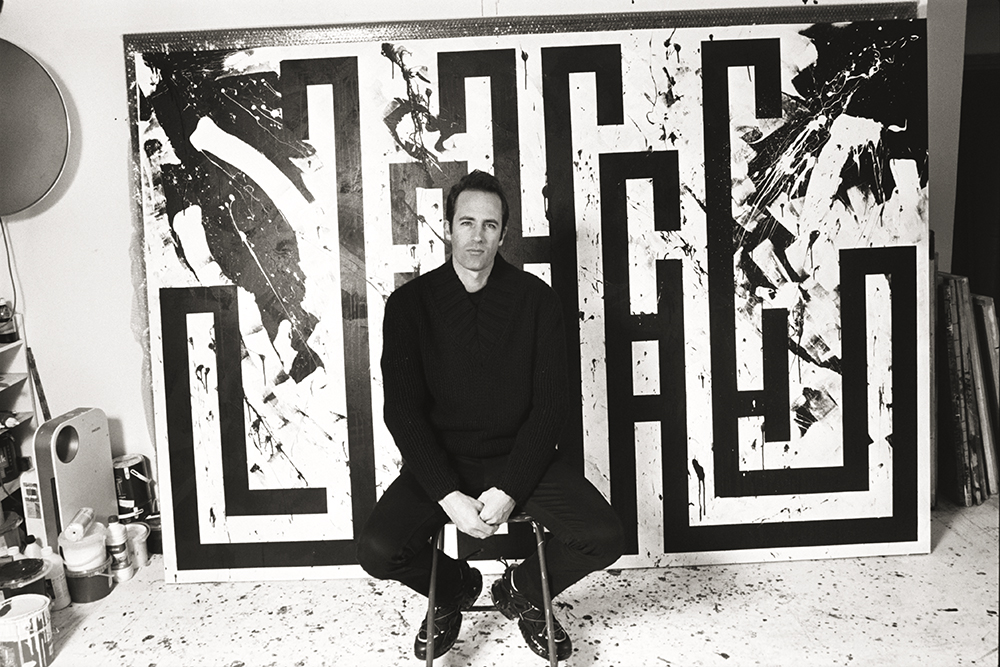
Rochas – Wool sweater
Jimmy Choo – Leather and stretch mesh «Diamonds Trail» sneakers
L’atlas’ own pants
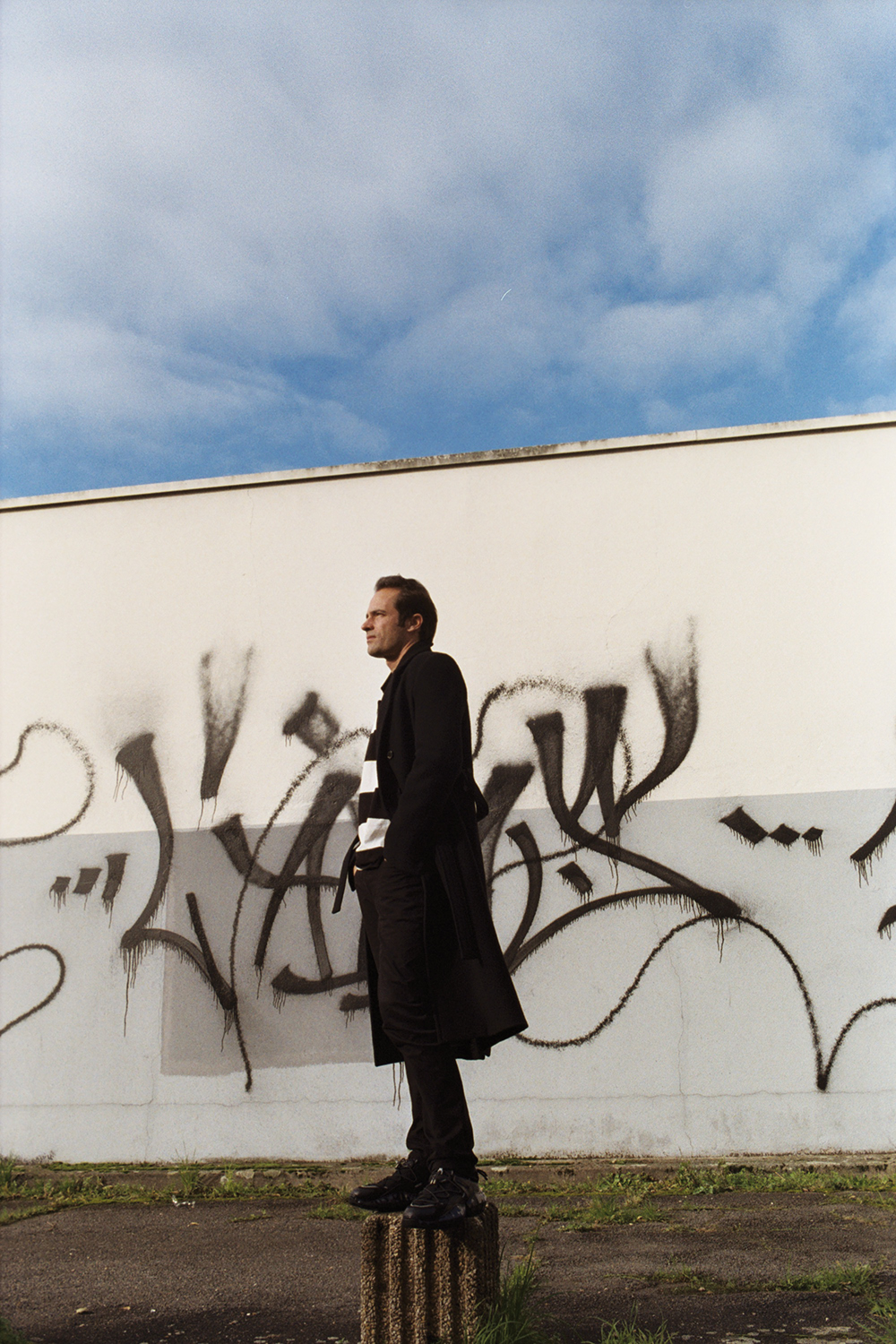
Rochas – Wool coat
Jimmy Choo – Leather and stretch mesh «Diamonds Trail» sneakers
L’atlas’ own top and pants
***
Interview by Armelle Leturcq.
Photos by Bertrand Jeannot.






